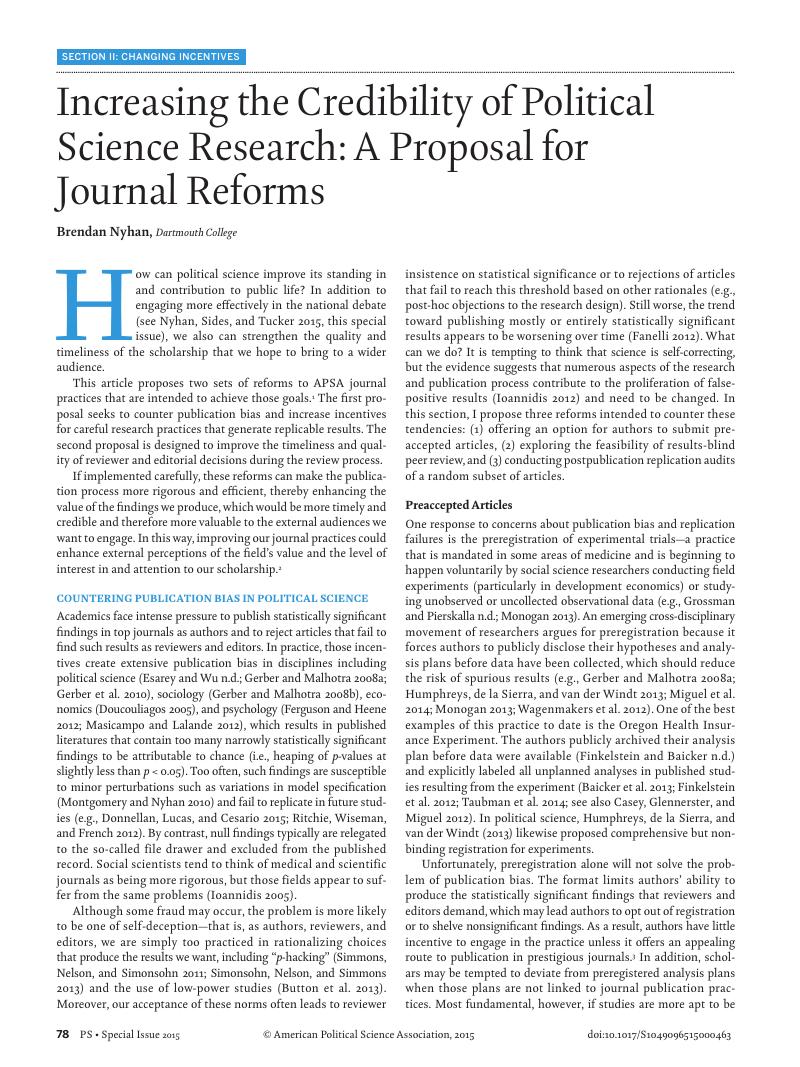Crossref Citations
This article has been cited by the following publications. This list is generated based on data provided by Crossref.
Cook, Bryan G.
2016.
Reforms in Academic Publishing: Should Behavioral Disorders and Special Education Journals Embrace Them?.
Behavioral Disorders,
Vol. 41,
Issue. 3,
p.
161.
Findley, Michael G.
Jensen, Nathan M.
Malesky, Edmund J.
and
Pepinsky, Thomas B.
2016.
Can Results-Free Review Reduce Publication Bias? The Results and Implications of a Pilot Study.
Comparative Political Studies,
Vol. 49,
Issue. 13,
p.
1667.
Samii, Cyrus
2016.
Causal Empiricism in Quantitative Research.
The Journal of Politics,
Vol. 78,
Issue. 3,
p.
941.
Maniadis, Zacharias
and
Tufano, Fabio
2017.
The Research Reproducibility Crisis and Economics of Science.
The Economic Journal,
Vol. 127,
Issue. 605,
p.
F200.
Gage, Nicholas A.
Cook, Bryan G.
and
Reichow, Brian
2017.
Publication Bias in Special Education Meta-Analyses.
Exceptional Children,
Vol. 83,
Issue. 4,
p.
428.
Elman, Colin
Kapiszewski, Diana
and
Lupia, Arthur
2018.
Transparent Social Inquiry: Implications for Political Science.
Annual Review of Political Science,
Vol. 21,
Issue. 1,
p.
29.
McCullough, B. D.
2018.
Quis custodiet ipsos custodes?: Despite evidence to the contrary, the American Economic Review concluded that all was well with its archive.
Economics,
Vol. 12,
Issue. 1,
Woznyj, Haley M.
Grenier, Kelcie
Ross, Roxanne
Banks, George C.
and
Rogelberg, Steven G.
2018.
Results-blind review: a masked crusader for science.
European Journal of Work and Organizational Psychology,
Vol. 27,
Issue. 5,
p.
561.
da Silva Frost, Aline
and
Ledgerwood, Alison
2020.
Calibrate your confidence in research findings: A tutorial on improving research methods and practices.
Journal of Pacific Rim Psychology,
Vol. 14,
Issue. ,
Wang, Y. Andre
and
Rhemtulla, Mijke
2021.
Power Analysis for Parameter Estimation in Structural Equation Modeling: A Discussion and Tutorial.
Advances in Methods and Practices in Psychological Science,
Vol. 4,
Issue. 1,
Gerring, John
Knutsen, Carl Henrik
and
Berge, Jonas
2022.
Does Democracy Matter?.
Annual Review of Political Science,
Vol. 25,
Issue. 1,
p.
357.
Abdelwahab, Siddig Ibrahim
Al-Zubairi, Adel S.
Taha, Manal Mohamed Elhassan
Oraibi, Bassem
Alfaifi, Hassan Ahmad
Aljahdali, Ieman A.
Jerah, Ahmed Ali
Abdullah, Saleh M.
Farasani, Abdullah
Babiker, Yasir
Alabsi, Aied M.
and
Elmanna, Abdalla
2025.
Bibliometric analysis of neutrophil elastase research in the post-COVID-19 era: trends, frontiers, differential mapping, and emerging trends.
Discover Applied Sciences,
Vol. 7,
Issue. 4,



